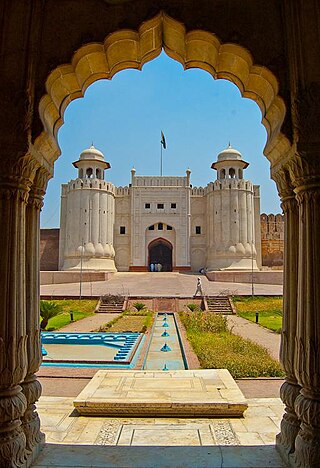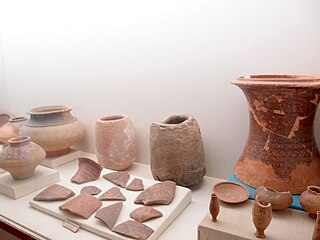Related Research Articles

Harappa is an archaeological site in Punjab, Pakistan, about 24 km (15 mi) west of Sahiwal. The Bronze Age Harappan civilisation, now more often called the Indus Valley Civilisation, is named after the site, which takes its name from a modern village near the former course of the Ravi River, which now runs 8 km (5.0 mi) to the north. The core of the Harappan civilisation extended over a large area, from Gujarat in the south, across Sindh and Rajasthan and extending into Punjab and Haryana. Numerous sites have been found outside the core area, including some as far east as Uttar Pradesh and as far west as Sutkagen-dor on the Makran coast of Balochistan, not far from Iran.

Mehrgarh is a Neolithic archaeological site situated on the Kacchi Plain of Balochistan in modern-day Pakistan. It is located near the Bolan Pass, to the west of the Indus River and between the modern-day Pakistani cities of Quetta, Kalat and Sibi. The site was discovered in 1974 by the French Archaeological Mission led by the French archaeologists Jean-François Jarrige and Catherine Jarrige. Mehrgarh was excavated continuously between 1974 and 1986, and again from 1997 to 2000. Archaeological material has been found in six mounds, and about 32,000 artifacts have been collected from the site. The earliest settlement at Mehrgarh, located in the northeast corner of the 495-acre (2.00 km2) site, was a small farming village dated between 7000 BCE and 5500 BCE.

Sir John Hubert Marshall was an English archaeologist who was Director-General of the Archaeological Survey of India from 1902 to 1928. He oversaw the excavations of Harappa and Mohenjo Daro, two of the main cities that comprise the Indus Valley Civilisation.

Taxila or Takshashila is a city in the Pothohar region of Punjab, Pakistan. Located in the Taxila Tehsil of Rawalpindi District, it lies approximately 25 kilometres (16 mi) northwest of the Islamabad–Rawalpindi metropolitan area and is just south of the Haripur District of Khyber Pakhtunkhwa.

The Gandhara grave culture of present-day Pakistan is known by its "protohistoric graves", which were spread mainly in the middle Swat River valley and named the Swat Protohistoric Graveyards Complex, dated in that region to c. 1200–800 BCE. The Italian Archaeological Mission to Pakistan (MAIP) holds that there are no burials with these features after 800 BCE. More recent studies by Pakistani scholars, such as Muhammad Zahir, consider that these protohistoric graves extended over a much wider geography and continued in existence from the 8th century BCE until the historic period. The core region was in the middle of the Swat River course and expanded to the valleys of Dir, Kunar, Chitral, and Peshawar. Protohistoric graves were present in north, central, and southern Khyber Pakhtunkhwa province as well as in north-western tribal areas, including Gilgit-Baltistan province, Taxila, and Salt Range in Punjab, Pakistan, along with their presence in Indian Kashmir, Ladakh, and Uttarakhand.

The Kulli culture was a prehistoric culture in southern Balochistan (Gedrosia) in Pakistan ca. 2500 - 2000 BCE. The pottery and other artifacts are similar to those of the Indus Valley civilization and it is not clear whether the Kulli culture is a local variation of the Indus Valley civilization or an own culture complex. The culture is named after an archaeological site discovered by Sir Aurel Stein.

Shahr-e Sukhteh, c. 3550–2300 BC, also spelled as Shahr-e Sūkhté and Shahr-i Sōkhta, is an archaeological site of a sizable Bronze Age urban settlement, associated with the Helmand culture. It is located in Sistan and Baluchistan Province, the southeastern part of Iran, on the bank of the Helmand River, near the Zahedan-Zabol road. It was placed on the UNESCO World Heritage List in June 2014.

Barikot is a town located in the middle course of the Swat River in Khyber Pakhtunkhwa, Pakistan. It is located about 20 km (12 mi) away from Mingora and the Butkara Stupa. It is the entrance town to the central Swat Valley with a population of approximately 25,000 people. Barikot is the location of an ancient citadel captured by Alexander the Great, with Chalcolithic remains dating back to c. 1700 BCE, and an early-historic period town dating back to c. 600 BCE. The Italian Archaeological Mission founded by Giuseppe Tucci has been excavating ruins of the ancient town of Bazira under Barikot since 1984.
Muhammad Rafiq Mugal is a Pakistani archaeologist, engaged in investigating of ethnoarchaeological research in Chitral, northern Pakistan. He has been responsible for the direction, technical support and supervision for restoration and conservation of more than thirty monuments and excavated remains of the Islamic, Buddhist and Proto-historic periods, in Punjab, Khyber-Pakhtunkhwa and Gilgit-Baltistan of Pakistan. He served as a professor of archaeology and heritage management and the director of undergraduate studies at Boston University. He is now Professor Emeritus of Archaeology at Boston University.

Buddhism in Pakistan took root some 2,300 years ago under the Mauryan king Ashoka who sent missionaries to the Kashmira-Gandhara region of North West Pakistan extending into Afghanistan, following the Third Buddhist council in Pataliputra.

Tourism in Pakistan is a growing industry. In 2010, Lonely Planet termed Pakistan "tourism's 'next big thing'". The country is geographically and ethnically diverse, and has a number of historical and cultural heritage sites. Condé Nast Traveller ranked Pakistan The Best Holiday Destination for 2020 and also declared it the third-highest potential adventure destination in the world for 2020. As security in the country improves, tourism increases; in two years, it has increased by more than 300%.

Taxila Museum is located at Taxila, Punjab, Pakistan. The museum is home to a significant and comprehensive collection of Gandharan art dating from the 1st to the 7th centuries CE. Most objects in the collection were excavated from the ruins of ancient Taxila.
Pakistani architecture is intertwined with the architecture of the broader Indian subcontinent. The major architectural styles popular in the past were Temple, Indo-Islamic, Mughal and Indo-Saracenic architecture, all of which have many regional varieties. With the beginning of the Indus civilization around the middle of the 3rd millennium BC, for the first time in the area which encompasses today's Pakistan an advanced urban culture developed with large structural facilities, some of which survive to this day. This was followed by the Gandhara style of Buddhist architecture that borrowed elements from Ancient Greece. These remnants are visible in the Gandhara capital of Taxila.

The Pothohar Plateau, also known as Pothwar, is a plateau in the northern region of Punjab, Pakistan, located between the Indus and Jhelum rivers.

Pakistan contains many of the oldest archaeological discoveries of the world. The country is home to many archaeological sites dating from Lower Paleolithic period to Mughal empire. The earliest known archaeological findings belong to the Soanian culture from the Soan Valley, near modern-day Islamabad. Soan Valley culture is considered as the best known Palaeolithic culture of Central Asia.

Nindowari, also known as Nindo Damb, is a Kulli archaeological site, dating back to chalcolithic period, in Kalat District of Balochistan, Pakistan. Archaeological investigation of the site suggests that the Nindowari complex was occupied by the Harappans before the Kulli civilization arrived and that the Kulli culture was related to or possibly derived from the Harappan culture.

Bhamala Stupa is a ruined Buddhist stupa and World Heritage Site near Haripur, Pakistan, that dates to the 2nd century CE. It is located on the banks of the Haro River, near Khanpur Dam, and is a tourist destination. Bhamala stupa is part of the larger Bhamala Buddhist Complex. The site is known for its 1,700-year-old statue of the Buddha attaining enlightenment—considered to be the oldest such statue in the world.
Hathial is an ancient archaeological site next to Bhir Mound, just south of Sirkap, in the area of Taxila in Pakistan. It is quite a large site, in which red burnished ware and various materials were discovered similar to those of Charsadda. This suggest that the establishment of the Hathial site may go back as far as 1000 BCE. The adjoining settlement of Bhir Mound was only created later, probably around 500 BCE.

The Manikyala Stupa or Mankiala Stupa is a Buddhist stupa near the village of Tope Mankiala, in the Pothohar region of Pakistan's Punjab province. The stupa was built to commemorate the spot, where according to the Jataka tales, an incarnation of the Buddha called Prince Sattva sacrificed himself to feed seven hungry tiger cubs.
Asma Ibrahim is a Pakistani archaeologist, museologist, and conservationist who is the founding director of the Museum, Archives and Art Gallery Department for the State Bank of Pakistan. Ibrahim has previously served as the curator and director of the National Museum of Pakistan.
References
- ↑ "Sarai Khola | archaeological site, Pakistan | Britannica". www.britannica.com.
- ↑ "PAKISTAN: pre-historic settlement discovered in Sarai Khoia near Texila 100' 16mm LIB".
- 1 2 3 4 Newspaper, the (December 26, 2010). "Sarai Khola a forgotten site in Taxila valley". DAWN.COM.
- ↑ Mughal, Mohammad Rafique (January 1, 1972). "Intro to Pottery of Period I & II of Sarai Khola and Pottery Types". Pakistan Archaeology, Number 8– via www.academia.edu.